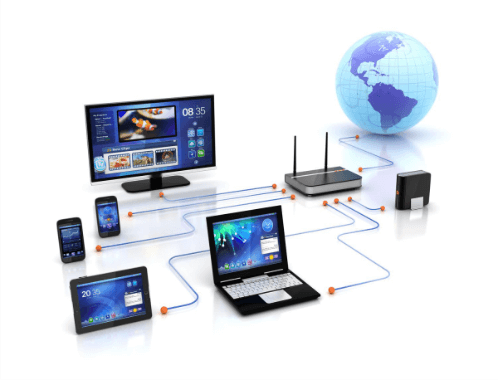Computer Network DefinitionA computer network is a system of interconnected devices that are linked together to share data, resources and information. This system is comprised of multiple computers, servers, storage devices, routers, switches, and other networking equipment. Computer networks allow multiple users to access shared resources, communicate with each other, and exchange data and information. 
About computer networks, size and rangeNetworks can range in size, from small local area networks (LANs) within a single building, to large, global wide area networks (WANs) that connect millions of devices across multiple locations. The most common type of computer network is a LAN, which is a small network that connects computers and devices within a limited geographic area, such as a home, office or building. WANs are much larger, connecting multiple LANs or other WANs over long distances, often spanning countries or even continents. A WAN can be created by connecting LANs with dedicated communication links, such as leased lines, satellite links or other means of long-distance communication. The architecture of a computer network can be classified into several different topologies, including star, bus, ring and mesh. In a star topology, all devices are connected to a central hub, which acts as a common communication point. In a bus topology, devices are connected to a single, linear cable that acts as the network backbone. In a ring topology, devices are connected in a loop, with data passing from one device to the next in a circular fashion. In a mesh topology, each device has a direct connection to every other device in the network. Computer networks also use various protocols to control the flow of data and communication between devices. The most common protocol used in computer networks is the Transmission Control Protocol/Internet Protocol (TCP/IP), which provides a standardized set of rules and guidelines for communication between devices. In addition to communication and data exchange, computer networks also provide users with access to shared resources, such as printers, storage devices, and applications. By connecting these resources to the network, multiple users can access them simultaneously, making collaboration and teamwork easier and more efficient. Networks can also be used to enhance security by implementing firewalls, intrusion detection systems, and other security measures to protect sensitive data and information from unauthorized access or theft. Networks can also be used to implement virtual private networks (VPNs), which provide secure and encrypted communication between remote users and devices. Types of Computer Networks
Network Devices
Network Services
Advantages of Computer Networks
Challenges of Computer Networks
ConclusionIn conclusion, computer networks play a critical role in today's technology-driven world, providing the infrastructure for communication and collaboration between users and devices. By connecting devices and sharing resources, computer networks help to increase efficiency and productivity, enhance security, and support the exchange of data and information.
Next TopicCondensation Definition
|
 For Videos Join Our Youtube Channel: Join Now
For Videos Join Our Youtube Channel: Join Now
Feedback
- Send your Feedback to [email protected]
Help Others, Please Share









